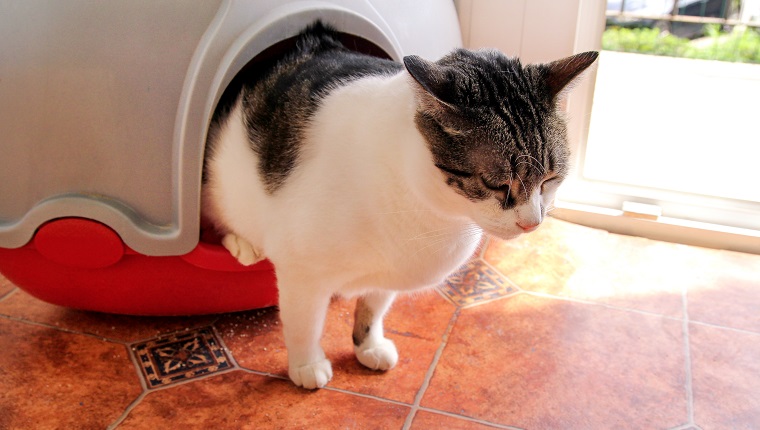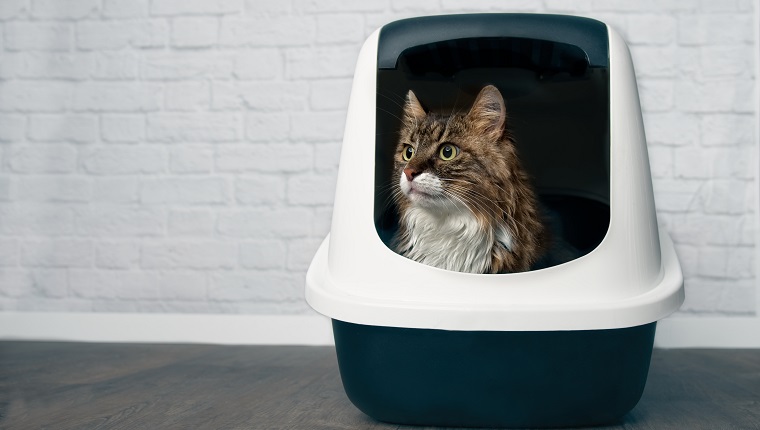Constipation is a relatively common problem in cats. It’s most frequently seen in older cats but can occur at any age. Even though it’s common, you should take it seriously if your cat shows symptoms.
When cats suffer from constipation, their colons absorb water from the feces stored there. This makes their stools hard and dry, which makes them even more difficult to pass. That can result in more straining, pain, and further complications.
Cats who experience constipation often can develop an enlarged colon, which cannot be fixed without surgery. This is why you must consult your veterinarian if your cat shows symptoms.
Here’s what you should know about the symptoms, causes, and treatments of constipation in cats.
Symptoms Of Constipation In Cats

The most common symptom of constipation is straining, either in the litter box or outside of it. However, it’s important to establish whether your cat is straining to urinate or defecate.
Urinary problems can cause a similar type of straining, and the inability to urinate can be an emergency situation that requires immediate veterinary care.
Cats with constipation often pass small amounts of very hard feces that may be blood-tinged. The appetite may be depressed and your cat may seem sluggish. Some cats will vomit.
Causes Of Constipation In Cats

There are many things that can cause feline constipation, including:
- Ingestion of excess amounts of hair while grooming (hairballs)
- Ingestion of foreign materials
- Dehydration
- Obesity
- Diseases, such as kidney failure, that can cause changes in your cat’s blood electrolyte levels
- Pelvic obstructions that may occur as a result of previous fractures or other injuries
- Tumors or growths in the digestive tract
Treatment Of Constipation In Cats

Treatment of constipation in cats often depends on the underlying cause.
If you suspect your cat may be suffering from dehydration, provide them with plenty of fresh water. Some cats do not drink enough water. You may wish to try a cat water fountain or a source of running water, as many cats prefer this to water from a bowl.
Some cats’ constipation clears up when they eat a spoonful of pureed pumpkin or another source of fiber. You may want try adding this to your cat’s meal.
However, it ultimately is best to consult your veterinarian. If your cat suffers from obesity, they can recommend diet changes and exercise. If there’s an underlying condition, your vet will determine what it is and treat it.
Your vet can also recommend medication, prescribe an enema, or manually remove feces from an impacted colon.
Enemas of several different varieties are used to treat constipation. Do not use over-the-counter enemas available for human use without vet approval. Many of these are toxic to cats.
Other medications that may be helpful in the treatment of constipation include:
- Stool softeners such as laxatives, DSS (dioctylsodium sulfosuccinate), or lactulose
- Drugs that improve intestinal motility such as cisapride or bisacodyl
A dietary change is also sometimes successful for cats with constipation.
- Some cats respond best to a low-residue diet that is highly digestible and promotes a smaller volume of feces. These diets are available commercially as therapeutic diets.
- Other cats may do better with a diet that is higher in fiber. If your cat will not tolerate the high-fiber commercial diets, you can add canned pumpkin to their diet. You can also add certain fiber supplements to your cat’s food. Consult your veterinarian for the proper dose.
Obstipation Versus Constipation

Obstipation is a severe form of constipation in which the cat’s colon is distended and packed with a large amount of very hard feces.
Cats that are obstipated are very uncomfortable and will strain, stop eating, become lethargic, and vomit. Liquid feces may sometimes be passed around the fecal mass leading a cat parent to believe that the cat has diarrhea.
Treatment of obstipation may require your cat to undergo anesthesia in order to have the hard feces manually removed from the colon. Fluid administration to combat dehydration and enemas to help soften the feces are required, also.
The dietary changes and medications commonly used for constipation are usually used for these cats, as well.
When To Seek Veterinary Care

If your cat has stopped eating, is vomiting, or seems uncomfortable, then it’s time to seek veterinary help.
Recurrent episodes of constipation will necessitate blood and urine testing to make sure your cat does not have a concurrent disease that requires treatment.
Many cases will clear up with some added fiber and water in the cats’ diets. However, if these do not resolve the issue within 24 hours or the condition returns, you should definitely talk to your veterinarian.
Has your cat ever suffered from constipation? How did you treat it? Let us know in the comments below!









